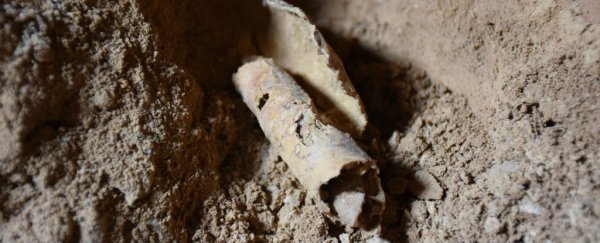They were treasured as five weathered survivors of the Dead Sea Scrolls: priceless fragments of a sacred scripture so ancient, it's older than the Old Testament.
The only problem is they're fakes. In a gigantic blunder, the US$500 million Museum of the Bible in Washington, DC has revealed five of its highly coveted Dead Sea Scrolls fragments are actually forgeries – and acknowledged other Scrolls relics in its collection could be rip-offs too.
According to the museum, independent tests by researchers in Germany indicate five of the institution's 16 Dead Sea Scrolls fragments "show characteristics inconsistent with ancient origin".
"Though we had hoped the testing would render different results, this is an opportunity to educate the public on the importance of verifying the authenticity of rare biblical artefacts," explains the museum's chief curatorial officer, Jeffrey Kloha.
It's not known how much the Museum of the Bible paid for its forged fragments, but estimates run into the millions.
The $500 million institution opened its doors late last year amid both fanfare and controversy.
Much of the criticism centred around the museum's evangelical backers – particularly its principal donor, the conservative Green family, whose company Hobby Lobby was fined $3 million last year for smuggling thousands of "looted antiquities" out of Iraq.
But it seems those weren't the only disputed items in the museum's orbit.
The Dead Sea Scrolls, a scattered collection of ancient parchment containing the oldest known text of the Hebrew Bible, are particularly prized specimens in the field of biblical archaeology.
The surviving fragments date as far back as the third century BCE, but were lost to history until a chance discovery in the 1940s, when shepherds in the West Bank found them stashed inside a cave.
Ever since, the haul – some 900 manuscripts and an estimated 50,000 fragments – have been intensively sought after by antiquities collectors, creating a thriving market for forgeries and fakes.
Which is exactly what seems to have caught out the Museum of the Bible.
Dead Sea Scrolls expert Kipp Davis from Trinity Western University voiced doubts about the authenticity of some of the fragments in 2017, and a high-tech analysis by scientists at the Federal Institute for Materials Research and Testing in Germany appears to have confirmed the suspicions.
Using 3D digital microscopy, scanning X-ray fluorescence (XRF) and energy-dispersive X-ray spectroscopy (EDX), the researchers analysed the ink and sediment in the fragments.
According to the museum, the results look to back up Davis's previous inklings, based on "scribal quality and technique in the penning of the texts as well as the physical composition and current state of the manuscript media."
On the available evidence, there is a "high probability that at least seven fragments in the museum's Dead Sea Scrolls collection are modern forgeries," Davis says, "but conclusions on the status of the remaining fragments are still forthcoming."
Until we know more, the Museum of the Bible has removed the five forgeries from public display, replacing them with three other fragments of the Dead Sea Scrolls.
Except, there's no guarantee these replacements are legit either.
While Khola insists the museum's acknowledgement of the forgeries demonstrates the museum's "commitment to transparency", Hebrew Bible expert Joel Baden from Yale Divinity School argues the fake fragments should never have been displayed in the first place before their (in)authenticity was determined.
Since the pedigree of the three replacements is also now up in the air, it looks like these disputed scrolls still have plenty of hidden secrets left to unfurl.
